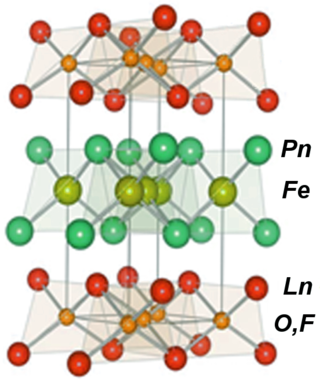Iron-based superconductor
From Wikipedia, the free encyclopedia
Iron-based superconductors (FeSC) are iron-containing chemical compounds whose superconducting properties were discovered in 2006.[2][3] The first of such superconducting compounds belong to the group of oxypnictides, which was known since 1995.[4] Until 2006, however, they were in the first stages of experimentation and implementation[5] and only the semiconductive properties of these compounds were known and patented.[6] Previously most high-temperature superconductors were cuprates containing copper - oxygen layers. Much of the interest in iron-based superconductors is precisely because of the differences from the cuprates, which may help lead to a theory of non-BCS-theory superconductivity.[7]

Iron-based superconductors of the group of oxypnictides were initially called ferropnictides. The crystal structure of these compounds displays conducting layers of iron and a pnictogen (typically arsenic (As) and phosphorus (P)) separated by a charge-reservoir block.[8] It has also been found that some iron chalcogens and crystallogens superconduct.[9][10]
The crystalline material, known chemically as LaOFeAs, stacks iron and arsenic layers, where the electrons flow, between planes of lanthanum and oxygen. Replacing up to 11 percent of the oxygen with fluorine improved the compound – it became superconductive at 26 kelvin, the team reports in the March 19, 2008 Journal of the American Chemical Society. Subsequent research from other groups suggests that replacing the lanthanum in LaOFeAs with other rare earth elements such as cerium, samarium, neodymium and praseodymium leads to superconductors that work at 52 kelvin.[7]
Iron-based superconductors are classified according to their crystal structure and chemical formula into the following main families,
- 1111-type, with representative compounds LaFePO,[2] LaFeAsO,[3] SmFeAsO,[11] PrFeAsO,[12][13] and LaFeSiH.[14]
- 111-type such as LiFeAs,[15][16][17] NaFeAs,[18][19][20] and LiFeP.[21]
- 11-type FeSe[22]
- 122-type such as BaFe2As2,[23] SrFe2As2[24] and CaFe2As2[25]
Superconductivity is obtained either in the parent phases of some of these systems (e.g. LaFePO,[2] LaFeSiH,[14] and LiFeAs[15][16][17]) or by means of doping or applied pressure.[8][26][27]
Undoped β-FeSe is the simplest iron-based superconductor but with distinct properties.[22] It has a critical temperature (Tc) of 8 K at normal pressure, and 36.7 K under high pressure[28] and by means of intercalation. The combination of both intercalation and higher pressure results in re-emerging superconductivity at Tc of up to 48 K (see,[22][29] and references therein).
Compared with other families, the synthesis of the 122 compounds is relatively easy which facilitates the investigation of these systems.
| Oxypnictide | Tc (K) |
|---|---|
| LaO0.89F0.11FeAs | 26[8] |
| LaO0.9F0.2FeAs | 28.5[30] |
| CeFeAsO0.84F0.16 | 41[8] |
| SmFeAsO0.9F0.1 | 43[8][11] |
| La0.5Y0.5FeAsO0.6 | 43.1[31] |
| NdFeAsO0.89F0.11 | 52[8] |
| PrFeAsO0.89F0.11 | 52[12] |
| ErFeAsO1−y | 45[32] |
| Al-32522 (CaAlOFeAs) | 30(As), 16.6 (P)[33] |
| Al-42622 (CaAlOFeAs) | 28.3(As), 17.2 (P)[34] |
| GdFeAsO0.85 | 53.5[35] |
| BaFe1.8Co0.2As2 | 25.3[36] |
| SmFeAsO~0.85 |
Compounds such as Sr2ScFePO3 discovered in 2009 are referred to as the '42622' family, as FePSr2ScO3.[41] Noteworthy is the synthesis of (Ca4Al2O6−y)(Fe2Pn2) (or Al-42622(Pn); Pn = As and P) using high-pressure synthesis technique. Al-42622(Pn) exhibit superconductivity for both Pn = As and P with the transition temperatures of 28.3 K and 17.1 K, respectively. The a-lattice parameters of Al-42622(Pn) (a = 3.713 Å and 3.692 Å for Pn = As and P, respectively) are smallest among the iron-pnictide superconductors. Correspondingly, Al-42622(As) has the smallest As–Fe–As bond angle (102.1°) and the largest As distance from the Fe planes (1.5 Å).[34] High-pressure technique also yields (Ca3Al2O5−y)(Fe2Pn2) (Pn = As and P), the first reported iron-based superconductors with the perovskite-based '32522' structure. The transition temperature (Tc) is 30.2 K for Pn = As and 16.6 K for Pn = P. The emergence of superconductivity is ascribed to the small tetragonal a-axis lattice constant of these materials. From these results, an empirical relationship was established between the a-axis lattice constant and Tc in iron-based superconductors.[33]
In 2009, it was shown that undoped iron pnictides had a magnetic quantum critical point deriving from competition between electronic localization and itinerancy.[42]

Properties
Summarize
Perspective
Similarly to superconducting cuprates, the properties of iron based superconductors change dramatically with doping. Parent compounds of FeSC are usually metals (unlike the cuprates) but, similarly to cuprates, are ordered antiferromagnetically that often termed as a spin-density wave (SDW). Some parent compounds superconduct.[2][14][15][16][17] Otherwise, superconductivity emerges upon either hole or electron doping. In general, the phase diagram is similar to the cuprates.[43]

Superconducting transition temperatures are listed in the tables (some at high pressure). BaFe1.8Co0.2As2 is predicted to have an upper critical field of 43 tesla from the measured coherence length of 2.8 nm.[36]
In 2011, Japanese scientists made a discovery which increased a metal compound's superconductivity by immersing iron-based compounds in hot alcoholic beverages such as red wine.[49][50] Earlier reports indicated that excess Fe is the cause of the bicollinear antiferromagnetic order and is not in favor of superconductivity. Further investigation revealed that weak acid has the ability to deintercalate the excess Fe from the interlayer sites. Therefore, weak acid annealing suppresses the antiferromagnetic correlation by deintercalating the excess Fe and, hence superconductivity is achieved.[51][52]
There is an empirical correlation of the transition temperature with electronic band structure: the Tc maximum is observed when some of the Fermi surface stays in proximity to Lifshitz topological transition.[43] Similar correlation has been later reported for high-Tc cuprates that indicates possible similarity of the superconductivity mechanisms in these two families of high temperature superconductors.[53]
Thin films
The critical temperature is increased further in thin-films of iron chalcogenides on suitable substrates. In 2015, a Tc of around 105–111 K was observed in thin films of iron selenide grown on strontium titanate.[54]
See also
References
Wikiwand - on
Seamless Wikipedia browsing. On steroids.
